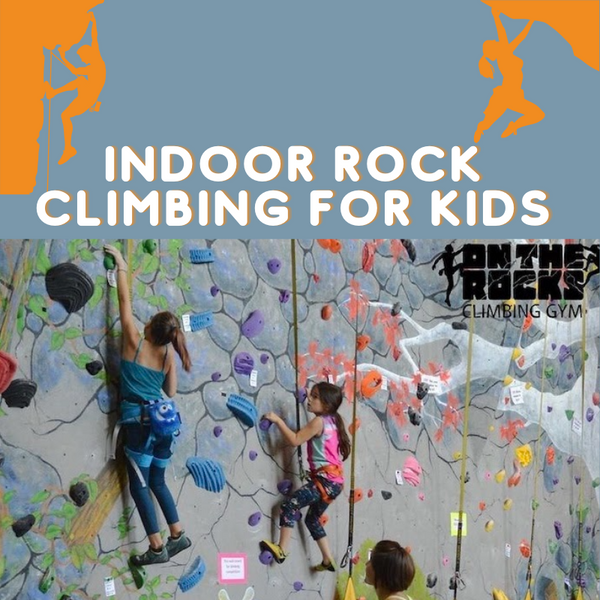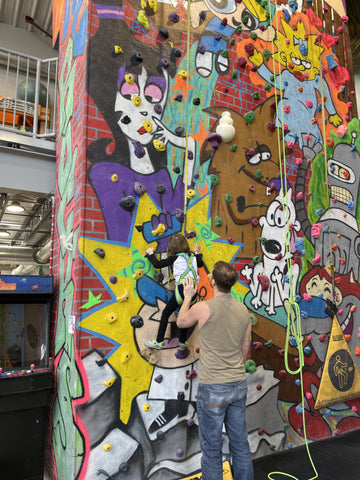
If you have kids who love adventure and a physical challenge, indoor rock climbing is a great activity to try. There are many benefits of climbing for kids, such as enhanced coordination, improved strength, motor improvements, and enhanced abilities to solve problems. With very little equipment required to rock climb, everything you need to know about rock climbing you can learn right at your local gym.
Importance of Indoor Rock Climbing for Kids
There are many reasons why climbing is so important for kids. With just one visit to your local indoor rock climbing gym, you can see your kid’s confidence shoot through the roof! Upon completing your visit, we can guarantee they’ll be asking to visit again and attempting more challenging climbs like bouldering.
When indoor rock climbing, your child’s hand, eye, and foot movements will be under the microscope, as your child reaches for holding placements, strategically places their feet, and climbs up and down the walls, they will have to focus on their body and their current tasks.
With this type of focus, they will enhance their skills in solving problems to maneuver through climbing routes and to find their way through a climb when they’re having difficulty. Indoor climbing centers are incredibly supportive when it comes to helping kids learn a new skill.
Kids will get one of the best workouts when they’re indoor rock climbing, using various muscles, building strength, and partaking in physical fitness. While kids might not realize how much physical power is required, after a few climbs up and down the rock, they’ll be in need of water. While this type of physical fitness isn’t for everything, indoor rock climbing for kids is considered a sport!
Types of Indoor Climbing for Kids
When exploring the world of rock climbing, you’ll quickly learn that there are two different types of rock climbing: bouldering and rope climbing. Bouldering is a form of free climbing where you’ll climb without a rope or harness. During a bouldering climb, your child will climb the walls with color-coded grips and footholds in different sizes.
Using their strength, they will ascend or descend using their grip and muscles to make their way around the climbing wall.
In comparison, rope climbing has color-coded grips on the indoor rock climbing wall. With rope climbing, kids will benefit from using a harness, a belay system, and a partner to help them belay from the bottom of the wall. These types of equipment will allow your child to climb higher while feeling secure from their climbing partner.
With indoor rock climbing for kids, rope climbing and bouldering both offer an exciting time. The two types of climbing techniques provide many benefits and chalk webs that might appeal to each child differently. So the next time you’re at your local climbing gym, give these two types of climbing forms a try!
When to Begin Indoor Rock Climbing for Kids

You might already know this, but even as babies, kids are always climbers. As parents, we all know this. When your kids were younger, you probably remember them trying to climb out of their cribs, climbing on the sofa, climbing up the steps, basically climbing anything that might be dangerous at such a young age.
Kids who are various types of ages will love indoor rock climbing, and they can begin as early as four to five years old. At this age, kids have excellent motor skills, can solve problems, and can follow directions to follow the gym rules. These are essential things to keep in mind when keeping your child as safe as possible during their climb.
Abilities for Indoor Rock Climbing for Kids
Kids need body awareness in order to use their strength and other areas of the body for strength and hand-eye coordination. When your child is harnessed on a climbing wall, they need to try and assess the situation to figure out their way through when they feel stuck and unable to achieve their next move.
Kids also need to be able to receive direction from the gym’s instructors in order to remain relaxed when climbing on the rock wall. Teenagers will most likely pick up quicker, but even the young ones can shock you with how well they can follow directions on a rock climbing wall.
In addition, many parents will begin their children rock climbing at the age of four or five. Without thinking about it, you may have encouraged your child to climb the rocks at a local park, so naturally, your child may be ready for indoor rock climbing. To confirm the minimum age, you should contact your area’s local gym.

Indoor Rock Climbing for Kids: Safety Facts You Should Know
When kids indoor rock climb, there are always risks, but when exercising property caution and safety, rock climbing is a safe sport. When taking your child rock climbing, there are some safety tips you’ll want to keep in mind.
With indoor rock climbing for kids, you should always stay aware of your surroundings and follow the directions of the gym staff. When rock climbing, it’s essential that your child correctly knows how to descend. Once your child has climbed as high as they want, you should encourage them to sit back and relax until they reach the ground.
To prevent your child from twisting their rope on their way down, tell them to remain focused on the rock climbing wall until their feet hit the floor.
Kid's Indoor Rock Climbing Gear
Two things you’ll want to make sure your child has when rock climbing are the right shoes and harness.
Kids Rock Climbing Shoes
When your child begins to show an interest in indoor rock climbing, the first thing you’ll want to invest in is a good pair of climbing shoes. Many children around 5 years old are more interested in bouldering than they are in rope climbing so rock climbing shoes might take priority over a harness in the beginning.
With an excellent pair of climbing shoes, you can take your small child to the gym to play around on the shorter walls. Kids will have fun bouldering around, especially if they have the correct-fitting climbing shoes that help them stick to the wall.
If you’re looking for an affordable kid’s climbing shoe, Stickits are an excellent option that you can adjust up to two sizes so your child will get use out of them even when they continue to grow.
Kids Climbing Harness
Once your child has a great pair of rock climbing shoes, it’s time for you to purchase a harness. There are many different harness designs out there today, so choosing the best one is an essential decision for your child.
If your child has an uncomfortable harness, this can play a crucial role in whether your child will enjoy rock climbing or not. So before you decide to buy, ensure you’re choosing the right one.
Many kids like a full-body harness, while others might like a traditional seat-style harness. Choosing the best harness for your child also depends on their size and age. Petite children benefit from a full-body harness because of its chest support to keep them upright.
To find the best harness for your child, you can visit your local rock climbing gear store to try on a few harnesses to see which ones they like the best. At local gyms, your child can also climb in a rental harness so they can understand the importance of wearing a comfortable harness.
Wrapping It Up
So, as you can see, indoor rock climbing for kids can be a fun experience for the entire family. As a parent, if you give enough patience and time, your kids can begin to have fun with rock climbing starting at a very young age.
As long as you introduce rock climbing in a fun and healthy way, rock climbing can be enjoyable for the entire family. If your goal is to raise strong, confident, and well-balanced children, you should teach them how to rock climb! Rock climbing will remain a fun memory they can hold onto for the rest of their lives.
Indoor Rock Climbing for Kids: FAQ
1. What do I wear for indoor rock climbing?
You should choose a flexible shirt and pants that aren’t too baggy and rock shoes.
2. What is bouldering in rock climbing?
Bouldering is a style of climbing that is done close to the ground without using ropes and harnesses and with a crash mat and the bottom for protection.
3. Do you wear socks with indoor rock climbing shoes?
Most climbers don’t wear socks with rock climbing shoes, as socks can alter the fit and impact performance.
